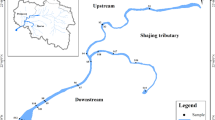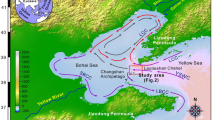Abstract
The vertical profiles, contamination levels, and potential ecological risks of mercury and arsenic were studied from the sediment cores of seven typical intertidal zones, including the Liaohe River Estuary, the Jianhe River Estuary, the Dagu River Estuary, Yancheng Shoal, the Dongtan Yangtze River Estuary, Hangzhou Bay, and the Pearl River Estuary. Marine sediment quality standards, the threshold effect level (TEL), and the probable effect level (PEL) were used as guidelines to evaluate sediment quality. In addition, the geo-accumulation index (Igeo) and potential ecological risk index (\( {E}_r^i \)) were used to assess contamination and potential ecological risks from mercury and arsenic. The results showed that the Pearl River Estuary was moderately polluted by mercury and represented a high potential ecological risk, while other areas were uncontaminated or mildly contaminated with low or moderate potential ecological risks. The Pearl River Estuary was mildly polluted by arsenic and represented a mild potential ecological risk, while other areas were unpolluted and also posed a mild potential ecological risk.





Similar content being viewed by others
References
AQSIQ (General Administration of Quality Supervision, inspection and quarantine of the People’s Republic of China) (2007). The speciation for marine monitoring-parting 5: sediment analysis (GB 17378.5-2007). Standards Press of China (in Chinese).
Araujo, B. F., Hintelmann, H., Dimock, B., Almeida, M. G., & Rezende, C. E. (2017). Concentrations and isotope ratios of mercury in sediments from shelf and continental slope at Campos Basin near Rio de Janeiro, Brazil. Chemosphere, 178, 42–50.
Benzer, S. (2017). Concentrations of arsenic and boron in water, sediment and the tissues of fish in Emet stream (Turkey). Bulletin of Environmental Contamination and Toxicology, 98(6), 805–810.
Bi, S., Yang, Y., Xu, C., Zhang, Y., Zhang, X., & Zhang, X. (2017). Distribution of heavy metals and environmental assessment of surface sediment of typical estuaries in eastern China. Marine Pollution Bulletin, 121(1–2), 357–366.
Centor, C. N. E. M. (1990). Chinese elemental background values for soils. Beijing: Chinese Environmental Science Press.
Chai, X. P., Hu, B. L., & Wei, N. (2015). Distribution, sources and assessment of heavy metals in surface sediments of the Hangzhou Bay and its adjacent areas. Acta Scientiae Circumstantiae, 35(12), 3906–3916 (in Chinese).
Chen, C. F., Ju, Y. R., Chen, C. W., & Dong, C. D. (2016). Vertical profile, contamination assessment, and source apportionment of heavy metals in sediment cores of Kaohsiung Harbor, Taiwan. Chemosphere, 165, 67–79.
Cheng, Q., Lou, G., Huang, W., & Li, X. (2017). Assessment and potential sources of metals in the surface sediments of the Yellow River Delta, eastern China. Environmental Science and Pollution Research International, 24(21), 17446–17454.
Delshab, H., Farshchi, P., & Keshavarzi, B. (2017). Geochemical distribution, fractionation and contamination assessment of heavy metals in marine sediments of the Asaluyeh port, Persian gulf. Marine Pollution Bulletin, 115(1–2), 401–411.
Duan, L., Song, J., Yuan, H., Li, X., & Li, N. (2013). Spatio-temporal distribution and environmental risk of arsenic in sediments of the East China Sea. Chemical Geology, 340, 21–31.
Duodu, G. O., Goonetilleke, A., & Ayoko, G. A. (2017). Potential bioavailability assessment, source apportionment and ecological risk of heavy metals in the sediment of Brisbane River estuary, Australia. Marine Pollution Bulletin, 117(1–2), 523–531.
Flemming, B. W., & Delafontaine, M. T. (2000). Mass physical properties of muddy intertidal sediments: some applications, misapplications and non-applications. Continental Shelf Research, 20, 1179–1197.
Gan, H. Y., Liang, K., & Zheng, Z. C. (2010). Background values, contamination assessment and zoning of heavy metals in sediments of the Pearl River estuary. Earth and Environment, 38(3), 344–350.
Gao, L., Gao, B., Xu, D., Peng, W., Lu, J., & Gao, J. (2017). Assessing remobilization characteristics of arsenic (As) in tributary sediment cores in the largest reservoir, China. Ecotoxicology and Environmental Safety, 140, 48–54.
Gu, Y. G., & Lin, Q. (2016). Trace metals in a sediment core from the largest mariculture base of the eastern Guangdong coast, South China: vertical distribution, speciation, and biological risk. Marine Pollution Bulletin, 113(1–2), 520–525.
Håkanson, L. (1979). An ecological risk index for aquatic pollution control—a sedimentological approach. Water Research, 14, 975–1001.
Hu, G., Bi, S., Xu, G., Zhang, Y., Mei, X., & Li, A. (2015). Distribution and assessment of heavy metals off the Changjiang River mouth and adjacent area during the past century and the relationship of the heavy metals with anthropogenic activity. Marine Pollution Bulletin, 96(1–2), 434–440.
Jiang, H. Y., Liu, X. B., Zhang, Q. F., R., H., Liu, Y., Bo, W. J., & Wang, Q. (2012). Distribution and risk analysis of heavy metals and as in the surface sediment of Tianjin offshore area. Marine Sciences, 37(9), 82–89.
Kumar, A., Singhal, R. K., Rout, S., & Ravi, P. M. (2013). Spatial geochemical variation of major and trace elements in the marine sediments of Mumbai Harbor bay. Environmental Earth Sciences, 70(7), 3057–3066.
Li, Y., & Li, H. G. (2017). Historical records of trace metals in core sediments from the Lianyungang coastal sea, Jiangsu, China. Marine Pollution Bulletin, 116(1–2), 56–63.
Liu, R., Men, C., Liu, Y., Yu, W., Xu, F., & Shen, Z. (2016). Spatial distribution and pollution evaluation of heavy metals in Yangtze estuary sediment. Marine Pollution Bulletin, 110(1), 564–571.
Liu, X., Zhang, L., & Zhang, L. (2017). Concentration, risk assessment, and source identification of heavy metals in surface sediments in Yinghai: a shellfish cultivation zone in Jiaozhou Bay, China. Marine Pollution Bulletin, 121(1–2), 216–221.
Long, R. E., & MacDonald, D. D. (1995). Incidence of adverse biological effects within ranges of chemical concentrations in marine and estuary sediments. Environmental Management, 19, 81–97.
Ma, L., Yang, X. B., Tong, C. Y., Wu, A. J., & Liu, M. H. (2008). The geochemical characteristics of heavy metal elements in sediments of Hunhe drainage area in Liaoning Province. Rock and Minarel Analysis, 27(3), 184–188.
Müller, G. (1969). Index of geo accumulation in sediments of the Rhine River. GeoJournal, 2, 108–118.
Najamuddin, T. P., Sanusi, H. S., & Wayan Nurjaya, I. (2016). Seasonal distribution and geochemical fractionation of heavy metals from surface sediment in a tropical estuary of Jeneberang River, Indonesia. Marine Pollution Bulletin, 111, 456–462.
Qian, X., Liang, B., Fu, W., Liu, X., & Cui, B. (2016). Polycyclic aromatic hydrocarbons (PAHs) in surface sediments from the intertidal zone of Bohai Bay, northeast China: spatial distribution, composition, sources and ecological risk assessment. Marine Pollution Bulletin, 112(1–2), 349–358.
Sarasiab, A. R., Hosseini, M., & Mirsalari, Z. (2014). Mercury distribution in contaminated surface sediments from four estuaries, Khuzestan shore, north part of Persian gulf. Bulletin of Environmental Contamination and Toxicology, 93(5), 522–525.
SEPA (2002). Marine sediment quality(GB 18668–2002). Standards Press of China.
Tao, Z. K., Bi, C. J., Chen, Z. L., & Wang, X. H. (2014). Pollution characteristics and assessment of heavy metals in the sediemnts from Dishui Lake. Resuorces and Environment in the Yantze Basin, 23(12), 1717–1720 (in Chinese).
Traverso-Soto, J. M., Lara-Martin, P. A., Gonzalez-Mazo, E., & Leon, V. M. (2015). Distribution of anionic and nonionic surfactants in a sewage-impacted Mediterranean coastal lagoon: inputs and seasonal variations. The Science of the Total Environment, 503-504, 87–96.
Wang, Z. H., Feng, J., & Nie, X. P. (2015). Recent environmental changes reflected by metals and biogenic elements in sediments from the Guishan Island, the Pearl River estuary, China. Estuarine, Coastal and Shelf Science, 164, 493–505.
Wang, H., Liu, R., Wang, Q., Xu, F., Men, C., & Shen, Z. (2016a). Bioavailability and risk assessment of arsenic in surface sediments of the Yangtze River estuary. Marine Pollution Bulletin, 113(1–2), 125–131.
Wang, J., Liu, G., Zhang, J., Liu, H., & Lam, P. K. (2016b). A 59-year sedimentary record of metal pollution in the sediment core from the Huaihe River, Huainan, Anhui, China. Environmental Science and Pollution Research International, 23(23), 23533–23545.
Williams, N., & Block, K. A. (2015). Spatial and vertical distribution of metals in sediment cores from Río Espíritu Santo estuary, Puerto Rico, United States. Marine Pollution Bulletin, 100, 445–452.
Ye, F., Huang, X. P., Zhang, D. W., Tian, L., & Zeng, Y. Y. (2012). Distribution of heavy metals in sediments of the Pearl River estuary, southern China: implications for sources and historical changes. Journal of Environmental Sciences, 24(4), 579–588.
Zhang, W., Cao, F., Yang, L., Dai, J., & Pang, X. (2017). Distribution, fractionation and risk assessment of mercury in surficial sediments of Nansi Lake, China. Environmental geochemistry and health.
Zuo, P., Zhao, S. D., Zhao, X. Q., Teng, H. F., Geng, J. J., & Gao, X. (2010). Distribution characteristics of heavy metals in surface sediments in original salt marshes in Yancheng, Jiangsu Province, China. Marine Science Bulletin, 29(4), 372–377.
Acknowledgements
This research was financially supported by the Youth Innovation Promotion Association (2011170) and the Equipment Development Project (YZ201558) of Chinese Academy of Sciences, and the Basic Survey of the Ministry of Science and Technology (2014FY10600). We thank MogoEdit for its linguistic assistance during the preparation of this manuscript. Additionally, the concentration of TOC and the sedimentation rate in sediment cores of this study and the grain size in sediment cores of the Dongtan Yangtze River Estuary and Hangzhou Bay are provided by Prof. Dongqi Wang (East China Normal University). The grain size in sediment cores of Liaohe River Estuary, the Jianhe River Estuary, and Yancheng Shoal are provided by Dr. Aiping Feng and Dr. Peng Xia (State Oceanic Administration). The grain size in sediment cores of the Dagu River Estuary are provided by Dr. Guohua Hou (Qingdao Institute of Marine Geology). The grain size in sediment cores of the Pearl River Estuary are provided by Prof. Dongyan Liu (East China Normal University) and Dr. Yujue Wang (Yantai Institute of Coastal Zone Research). We thank these participators for the supply of the data, which make this study more integrated and more meaningful.
Author information
Authors and Affiliations
Corresponding author
Electronic supplementary material
ESM 1
(DOC 75 kb)
Rights and permissions
About this article
Cite this article
Wang, C., Pan, D., Han, H. et al. Vertical profile, contamination assessment of mercury and arsenic in sediment cores from typical intertidal zones of China. Environ Monit Assess 190, 366 (2018). https://doi.org/10.1007/s10661-018-6732-1
Received:
Accepted:
Published:
DOI: https://doi.org/10.1007/s10661-018-6732-1




